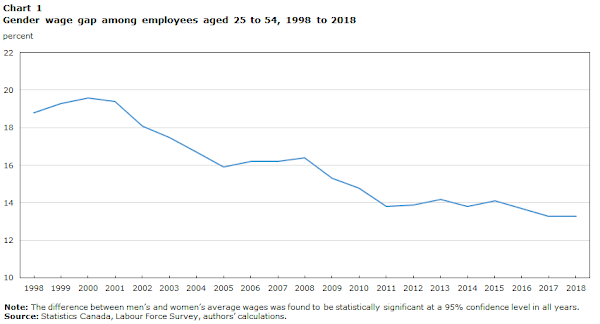In the private sector, the wage disparity between men and women is greater. By 2020, the majority of EU nations (for which statistics are available) will have a larger gender pay gap in the private sector than in the public sector (in absolute terms) (Table 3). This might be because, in the majority of nations, public sector compensation is established by clear salary grids that apply equally to men and women. In the commercial sector, the gender pay gap ranged from 8.5 percent in Belgium to 22.6 percent in Germany, while in the public sector, it ranged from -0.6 percent in Poland to 18.4 percent in Latvia. Eurostat Unadjusted gender wage disparities by economic control (percentage), Eurostat (earn gr gpgr2ct), 2020
Over the last 15 years or more, the gender wage gap has been largely steady in the United States. According to a Pew Research Center survey of median hourly wages for full- and part-time employees in 2020, women earned 84 percent of what men earned. According to this projection, it would take women an additional 42 days of labor to earn what males earned in 2020. As has been the case in previous decades, the salary disparity between employees aged 25 to 34 and all workers 16 and older was reduced in 2020. On average, women aged 25 to 34 earned 93 cents for every dollar earned by males in the same age range. Women between the ages of 25 and 34 earned 33 cents less than their male counterparts in 1980, but just 7 cents in 2020. In 2020, the predicted gender pay difference for all employees will be 16 cents, down from 36 cents in 1980.
As a working mother with a full-time job, two children, and a loyal spouse, I understand how serious this situation is. As is the case with the majority of things in life, it is complicated and messy. However, it is critical that we as a society spend time addressing problems such as the gender wage gap and possible solutions.
According to the German Federal Statistical Office, women earn 22â23 percent less than males. In the years 2006–2013, the corrected gender pay gap was 68%. [124] The Cologne Institute for Economic Research revised the pay disparity downward to less than 2%. They lowered the gender wage gap from 25% to 11% by accounting for labor hours, education, and length of employment. Additionally, the revenue disparity was minimized if women had not taken a break from work for longer than 18 months owing to maternity. [125] [126] Part-time employment, education, and occupational segregation are the most prominent variables contributing to the continuing gender pay disparity (less women in leading positions and in fields like STEM). [127]










